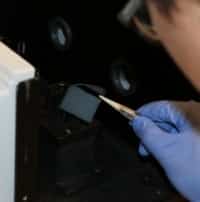Researchers from Massachusetts Institute of Technology (MIT) and the Masdar Institute have created a new type of solar absorber capable of increasing the amount of sunlight that can be converted into heat.
The discovery could help lower the cost solar thermal technologies that use heat for energy production according to Dr Tie Jun Zhang, Assistant Professor of Mechanical and Materials Engineering at Masdar.
“Our research team has developed a simple and cost-effective fabrication technique to create solar absorbers that can harness a greater share of the solar spectrum, thus increasing their efficiencies, while also maintaining low emission levels.”
By exploiting a field of technology called plasmonics – the study of the interaction between light’s electromagnetic field and free electrons in a metal – the team’s device is capable of absorbing nearly 90 percent of all the wavelengths of light that reach Earth’s surface.
As sunlight strikes a conventional solar absorber and it heats up, energy is wasted in the form of thermal radiation “bounced” back into the atmosphere.
The MIT/Masdar device’s unique design involves patterning a solar absorber with light-trapping holes only 400 nanometres in diameter (1/200th the width of a human hair). These holes penetrate the entire device, vastly increasing the range of solar energy that can be absorbed.
To cut costs, the device is fabricated using just two layers of material: a semiconductor film and a reflective metallic layer, with a thickness of 170 nanometres.
“This idea can be applied to most conventional solar absorbers. With this unique patterning, the absorbers can be boosted to harvest more solar energy from the ultraviolet and visible regions of the electromagnetic spectrum,” said Masdar Institute postdoctoral researcher Dr. Jin You Lu.
Lu believes they have found the “sweet spot” of solar absorbing technology; the point where optimal levels of sunlight are converted with the least amount of energy escaping.
“By taking advantage of the ultrathin film coatings and patterning, we are able to maximize the absorption spectrum while keeping the solar absorber’s emission levels quite low,” Lu said.
The joint research into enhanced solar absorbing technology is part of a MIT and the Abu Dhabi-based Masdar Institute Cooperative Program aimed at developing a solar-powered combined electrical power plant and cooling system.
A paper describing the research was published this month in the journal Advanced Optical Materials.
Source/image source: MIT and Masdar Institute.












































